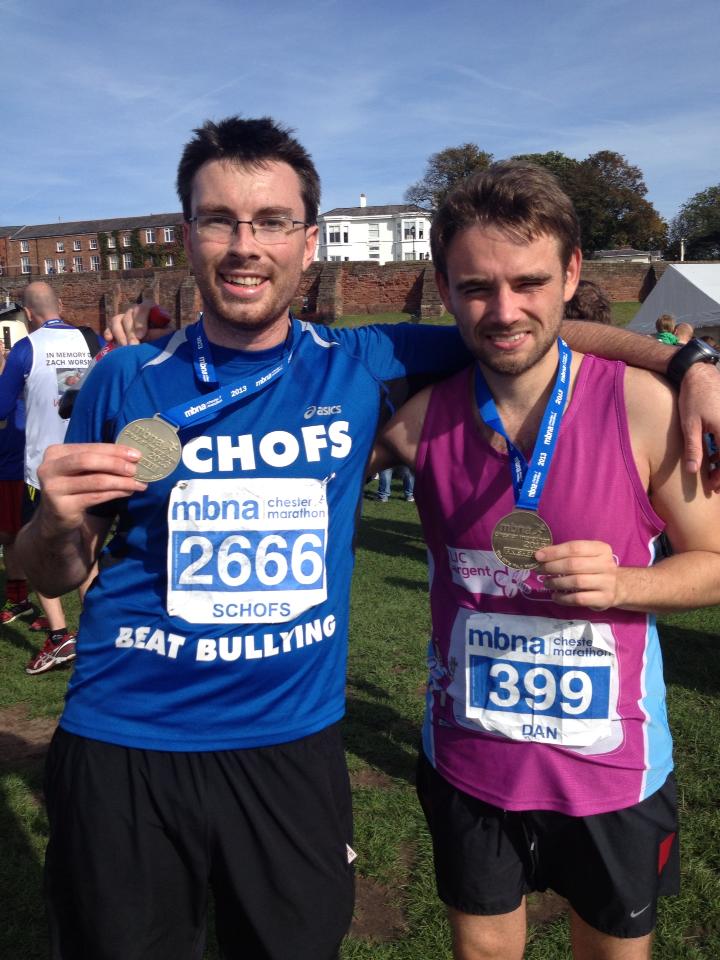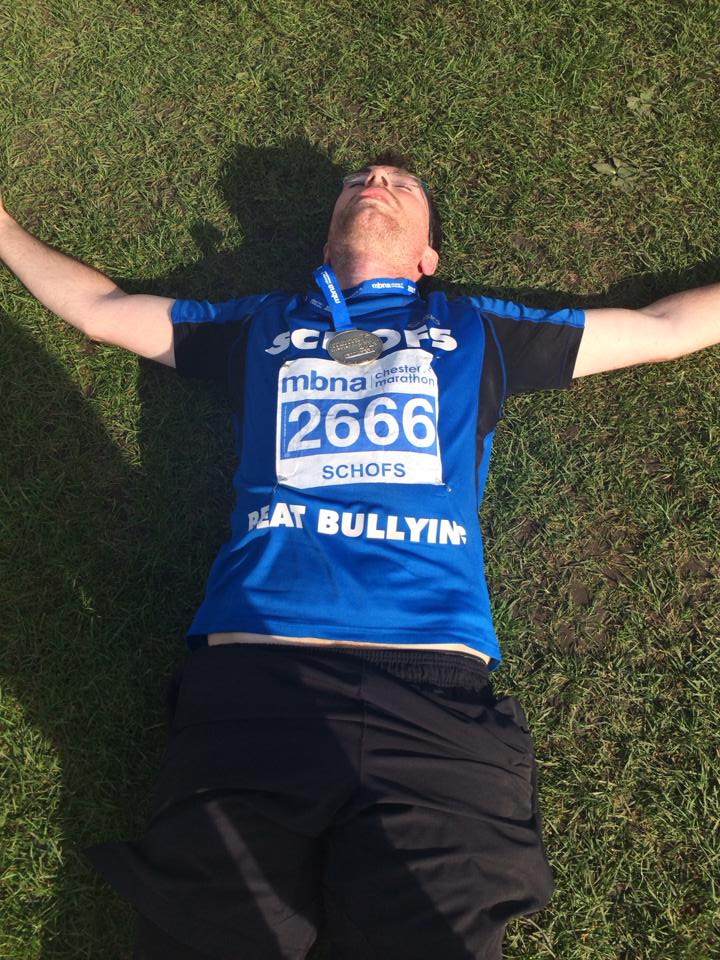Art of Undertraining
A week ago, I heard Team GB runner Scott Overall say that it’s better to go into a race under-trained than over-trained. This was lucky, as I was about to run Chester Marathon, and my longest run in the last 6 months was 3 miles.
This wasn’t because I didn’t want to train, it was just that the gods of running have determined that I don’t have the necessary legs to do any sort of distance running. In fact I was gutted that I couldn’t train, as I knew I was capable of a much better time than I’d set in the London Marathon last year (4:52:07) where I’d trained, but suffered severe cramp from mile 17.
Had I been due to run Chester on my own, there’s no way I’d have made the journey there and even toed the start line, but I wasn’t. I was running with a friend from work who was making their marathon debut and had done the proper training. When I say with, I don’t mean alongside, I just mean at the same time – there was no way I was going to keep up with him.
Every race needs a strategy, and this one was really very simple. Start without expecting to finish. In fact, when people asked me if I had a target [time] in mind, I’d generally say “Half way” as I knew from my Hastings Half that I could do that distance without any training. I decided to therefore do Run/Walk strategy which would give me the best possible chance of reaching half way.
There’s one good thing about having no expectation of finishing a race. No pressure. In contrast to London where I was worried I wouldn’t complete it, this time I had no such fears. I wasn’t really worried about injury either because if something felt wrong, I’d just stop. Simple.
The gun went, and the race started. I’d positioned myself near the 4:15 pacer, and due to the first mile being on a narrow horse-racing track, it was a gentle pace as the crowd of runners shuffled through. This I could handle. I didn’t feel the need to jostle for position or run around other runners who were in my way – why bother? It would be energy wasted in a run I wasn’t going to finish.
I reached the first 10km checkpoint in 56:23. The run/walk strategy was working well – I’ve only run a 10km race once in my life 7 years ago, and just snuck under the hour mark then, so I was happy with this time.
Then I looked up and noticed a problem. I’d caught up with the 4 hour pacer. This was actually 2 problems. 1) There was no way I was in the right shape for a 4 hour marathon, and 2) everybody in the world follows the 4 hour pacer, so my constant alternating between running and walking was going to piss off the masses. But then, sod ’em – they can run their own race.
I decided to drop back a bit to give myself some space.
I passed the 20km checkpoint in 1:55:53. Again I was pretty happy with this pace because I had bags of energy still, and I was only 1km away from the Half-way checkpoint. Which was lucky, because about 10 steps after the 20km I got my first twinges of cramp in my calves.
I tried to walk it off, but the cramp wasn’t going. I then stretched at the side of the road, and power walked to the half way marker, where I would have reached my goal and end the race. I got to the Half Marathon point at 2:03:38 – my second best ever Half Marathon time – it was even better than the Reading half when I was at the peak of my London 2012 training, and I’d walked most of this one!
This presented the next problem. I couldn’t really bow out at half way, as I was in the middle of the countryside. I didn’t really have much option other than to power walk until the next proper drinks stop… at mile 15!
This gave me a bit of time to experiment with pain. What was the fastest way of getting to the 15 mile drinks station in as little pain as possible. It seemed that walking, whatever the speed, did not in any way irritate the calf cramp, but jogging even slowly did. So I basically walked as fast as I could – the pace varied between 11 and 13 minute miles, and I watched my average pace on my GPS watch drop.
I reached 15 miles, and had a good stretch. I was still in the country though, and I began to realise something. It’s not like the London marathon where if I’d wanted to stop, I could just get on the nearest tube and meet up with people. Dropping out meant waiting for the sweeper bus which crawled around at the end at a 6 hour pace.
At which point I heard myself say the following – I just can’t be arsed to pull out of the marathon. Seriously – it sounded so stupid saying it, but it was true. To give up would be more hassle logistically than doing another 11 miles with now-pretty-severe cramp.
So I carried on. The 4:15 pacer passed me, and I was amazed that it had taken so long for them to catch me up. Conversely, it seemed very soon after when the 4:30 pacer overtook me.
I decided to find a gate by the side of the road that wasn’t occupied by cows watching the runners, and spent a minute or so stretching out my calves. I then rubbed and squeezed them as though I knew what I was doing, and started to jog for a bit. This then continued every 2-3 minutes for 8 miles; jog, walk, stretch. For those 8 miles, I kept seeing the same people repeatedly as I’d pass them during my jog, and be passed by them during my stretch. It became quite sociable. What’s more, I felt like it was slowing the creeping-death of the 4:45 pacer on my tail.
My watch beeped for 23 miles exactly as I passed the 23 mile marker. I was amazed at how accurate the Garmin I bought at the start of the year was being. And then, at exactly 23.4 miles, I passed the 24 mile marker. Now I was confused. A few hundred yards up the road the crowds were shouting “Less than 2 miles to go!”
My Garmin had been suspiciously accurate the whole way… but what if it wasn’t? What if the person who had the job of laying out mile markers 1 to 23 had used a similarly inaccurate GPS device, and then a different bloke was given the job of laying out mile markers 26, 25 and 24 and was measuring back from the finish line. That was entirely possible, and that meant there was significantly less than a parkrun to go! I was at 4:12 on the watch, meaning I was 40 minutes away from my London finishing time. I knew from being a tail-runner at parkrun that I could walk the 3.1 miles in 43 minutes. Suddenly this was a race against myself.
It was a further 1.6 miles before I saw the 25-mile mark. That ruled out the “all markers from 1-23 were wrong” theory, and pretty much confirmed the slightly more probable “only mile marker 24 is wrong” theory.
But it didn’t matter. There was only 1.2 miles left, and I still had masses of energy. My calves were shot, but I gave them one really good stretch and started jogging. I started and I didn’t stop. For some reason, my calves let me jog at just over 9 minute mile pace. We then entered the race track where we’d started, and I could see the finish line. Dan and his social-boss Katy were on the finishing straight yelling at me and I absolutely caned it – I ran the last 300 metres at 7 minute mile pace, passed dozens of people, and crossed the line in 4:41:10.
To say I was shocked doesn’t quite cut it. I trained for 4 months over hundreds of miles in preparation for the 2012 London Marathon. I then turn up to Chester with zero training runs and not only finish, but do it 11 minutes quicker? I would be less shocked if you told me Elton John was a homophobe.
Dan (as a result of his training no doubt!) finished in a stonking time of 4:05, and had a little cry on the finish line.








